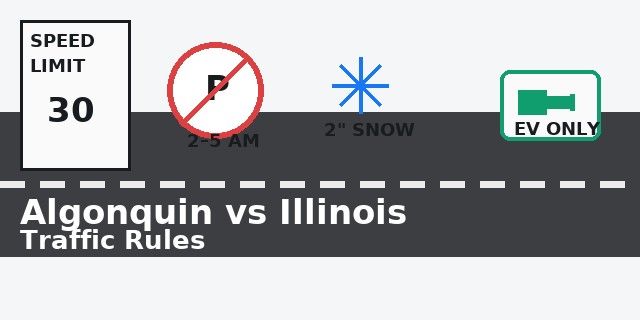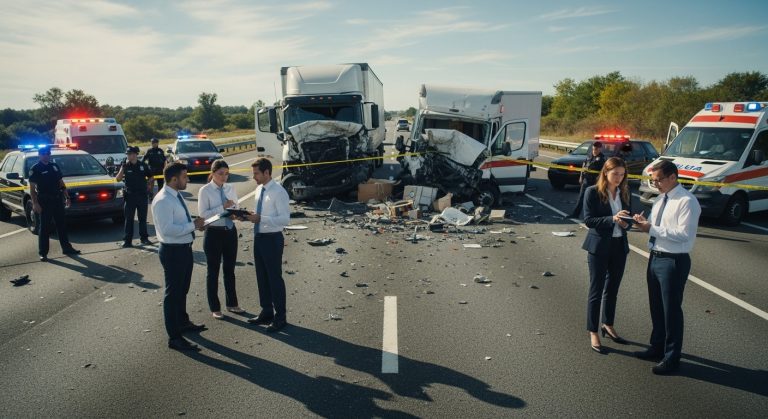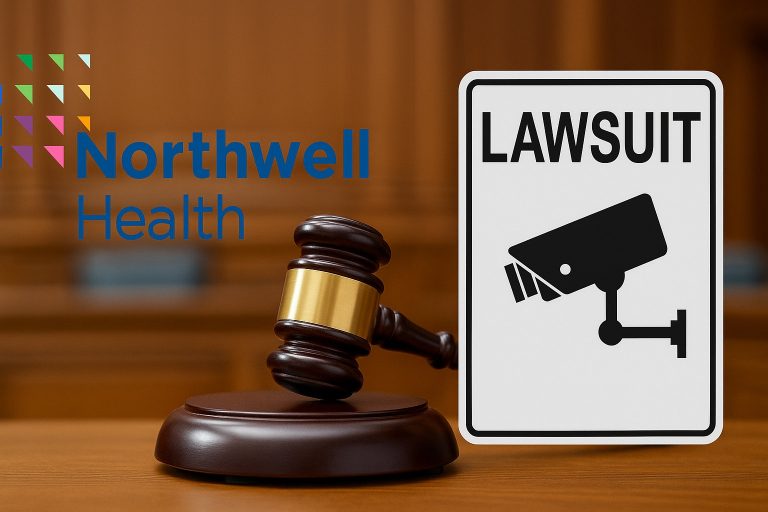People ask a simple question. Are traffic laws of Algonquin the same as Illinois? The answer matters to residents and visitors. Drivers want clarity before a stop or a ticket. Local rules can change parking or turns. State rules control driving almost everywhere. Village rules then shape details on local streets. The goal of this guide is clarity. You get a clean local-versus-state map. You also get practical tips and short answers. Read on and drive confidently through Algonquin.
How state and local rules interact
State rules create the backbone. Village rules build on that structure where allowed. The sections below connect the legal framework to daily driving.
Uniform rules statewide
Illinois sets core driving standards across all towns. Those standards define movement, equipment, and licensing. Courts and officers apply those standards every day. Drivers feel a consistent baseline wherever they travel.
Local authority scope
Municipalities add rules that do not conflict. Topics include parking, stops, signals, and posted speeds. Towns act within their street network. Signs and markings inform drivers at the curb.
Signage and notice
Local rules require clear notice. Proper signs carry legal force after installation. Painted markings support enforcement when needed. Drivers should scan poles, curbs, and pavement.
Road jurisdiction
Ownership shapes which agency sets controls. The village sets rules on village streets. Counties and the state post controls on their roads. Reading signs remains the safest approach.
What Algonquin adopts from Illinois
Algonquin aligns closely with state law. The village adopts state vehicle rules in full. The next subsections show how that adoption works in daily life.
Adoption by reference
The village incorporates the Illinois Vehicle Code. That adoption keeps definitions and penalties aligned. Officers can cite familiar sections inside the village. Drivers face the same core expectations.
Section numbering and enforcement
The village mirrors state section numbers. That choice simplifies training and court work. Attorneys read the same structure across jurisdictions. Outcomes remain more predictable for drivers.
Where local ordinances layer in
Village chapters add targeted topics. Examples include winter parking and EV stalls. Intersections receive local stop and yield designations. Administrative hearings handle many parking matters.
Statewide rules you follow in Algonquin
These statewide rules apply inside the village. Local postings may sharpen details on certain blocks. The following subsections give clear, practical summaries.
Speed limits and defaults
Illinois sets 30 mph inside urban districts unless posted. Higher limits appear on divided highways and interstates. Lower limits apply near schools and parks. Posted signs control every block.
School zones
School zones use 20 mph when children are present. Signs define start and end points for drivers. Crossing staff improve safety at peak times. Extra caution protects students each day.
Seat belts and child restraints
Seat belts are required in every seating position. Children need age- and size-appropriate restraints. Caregivers should check seat ratings carefully. Rideshares and taxis follow the same rule.
Mobile devices and distracted driving
Handheld phone use remains prohibited for drivers. Adults may use hands-free systems when legal. Novice drivers face stricter device limits. Texting counts as device use while moving.
DUI and impairment
A 0.08 BAC limit applies to most drivers. Certain drivers face lower limits under law. Drugs and combined influence also violate standards. Implied consent rules follow an arrest.
Traffic signals and stop signs
Drivers must obey official signals and signs. Flashing red means stop, then proceed when safe. Flashing yellow means proceed with caution. Dark signals require a four-way stop.
Right-of-way basics
Yield to pedestrians in marked crosswalks. Yield to traffic already inside a roundabout. Give way during merges into through lanes. Safety overrides any claim of right-of-way.
Passing and lane use
Pass only when safe and legal. Keep right except when passing or turning left. Solid lines restrict passing zones. Provide room for cyclists and motorcycles.
Turning rules
Signal at least 100 feet before urban turns. Use the correct lane for each maneuver. Stop fully before permitted right turns on red. Obey posted “no turn” restrictions.
Headlights and visibility
Use headlights from sunset to sunrise. Use headlights during rain, fog, or snow. Dim high beams near oncoming traffic. Keep lenses clean for better output.
Work zones
Slow down inside signed work zones. Expect narrowed lanes and shifting patterns. Workers may move near live lanes. Fines often increase in these areas.
Move Over law
Move over for stopped emergency vehicles. Slow down when a lane change is unsafe. The rule covers police, fire, and EMS. Service and utility vehicles often qualify.
Railroad crossings
Stop when active warnings engage. Never drive around gates under any condition. Never stop on the tracks. Hazmat carriers face additional requirements.
School buses
Stop for extended stop arms on two-lane roads. Stop on undivided multi-lane roads as well. Proceed only after the arm retracts. Children require a wide safety buffer.
Pedestrians and crosswalks
Yield to pedestrians inside crosswalks. Stop when a neighbor lane has stopped. Never pass a car stopped at a crosswalk. Blind pedestrians have priority.
Cyclists and micromobility
Expect bicycles inside the travel lane. Provide at least three feet when passing. E-bikes and scooters follow device-specific rules. Check signs at trails and path crossings.
Equipment standards
Maintain brakes, tires, and lights in good order. Replace cracked windshields promptly. Clear ice and snow from glass. Keep plates visible and readable.
Insurance and registration
Carry proof of insurance during operation. Maintain current registration and stickers. Electronic insurance proof is acceptable. Officers may verify coverage electronically.
Licensing
Carry a valid driver’s license. Follow restrictions during permit and probationary stages. Medical conditions can trigger specific limits. Serious offenses can suspend driving rights.
Commercial drivers
CDL holders face stricter impairment standards. Out-of-service orders carry steep penalties. Logbook and equipment rules apply broadly. Federal rules remain paramount for CDL matters.
What’s different inside Algonquin
Local differences focus on parking, postings, and process. The subsections below show what changes inside village limits.
Overnight street parking
On-street parking is banned from 2:00 a.m. to 5:00 a.m. That rule covers every village street. Limited exceptions may exist through requests. Visitors should plan driveway or lot options.
Winter parking and snow events
A two-inch snowfall triggers a street parking ban. Plows must clear lanes and corners first. Crews need space to push snow aside. Towing can occur during heavy storms.
Local speed postings on named roads
Village corridors carry tailored speed postings. Many neighborhood streets post 25 mph. Other arterials post 30, 35, 40, or 45 mph. The sign at the curb controls your speed.
EV-charger stall rules
Only actively charging EVs may occupy posted charging stalls. Gas vehicles cannot park in those spaces. Idle EVs cannot occupy them either. Tow-away language often appears on signs.
Administrative hearings and local process
The village operates an administrative hearing system. Parking and compliance cases appear on that docket. Moving violations remain outside that process. County courts handle those offenses.
Automated enforcement status
The village ended its red-light camera program in 2016. The code still contains enabling language. A program could return only after approvals. No active cameras operate today.
Oversize and overload permits
Heavy or large loads need a village permit. Applicants often apply through an online portal. Routing protects bridges, pavement, and neighborhoods. Escorts and specific hours may apply.
Residential truck and trailer parking
Large commercial vehicles face residential restrictions. Time limits or location bans can apply. Signs and code language set the thresholds. Owners should use approved yards or lots.
Turn restrictions and protected phases
Specific intersections carry time-based turn bans. Protected left arrows control yields during peaks. Signs and signal plates define each rule. Read plates carefully at every approach.
Stop and yield designations
The village lists official stop and yield points. Crews install signs after engineering reviews. Multi-way stops follow warrant criteria. Sight distance and crash data shape choices.
Downtown time limits and night rules
Main Street blocks often use two-hour limits. Night hours also follow the 2:00 a.m. to 5:00 a.m. ban. Delivery windows appear near alleys. Check every pole before you walk away.
Private property enforcement
Property owners can request limited enforcement. Officers enforce posted rules after agreements. Signs must match recognized standards. Tow policies must display clearly.
Work near schools and parks
Seasonal slow zones protect children and families. Arrival and dismissal create heavy foot traffic. Crossing guards direct action at peaks. Drivers should yield early and wait.
Construction detours and temporary rules
Projects may add temporary bans and shifts. Portable signs carry full legal force. Cones and barrels create protected paths. Navigation apps may lag during changes.
Special events and parades
Events create closures and temporary parking rules. Permit holders coordinate routes and detours. Signs direct traffic around venues. Plan alternate routes before arrival.
River corridor and trail crossings
Trail crossings demand extra vigilance. Bikes and joggers can enter suddenly. Yield and stop signs control several paths. Slow early and cover the brake.
Snow routes and cul-de-sacs
Designated snow routes need full access. Cul-de-sacs require extra maneuvering room. Residents should move cars into driveways. Crews finish faster when streets remain clear.
Towing and immobilization
Illegal parking can trigger towing or boots. Repeat offenders face escalating consequences. Owners must clear fines before release. Storage fees can add up quickly.
Payment, appeals, and timelines
Parking tickets list payment and appeal details. Missed deadlines can add late penalties. Hearing schedules appear on village notices. Keep records of submissions and receipts.
Record impact and insurance
Parking citations do not affect licenses. Moving violations can raise insurance rates. Serious offenses can suspend driving privileges. SR-22 filings may follow certain cases.
Quick comparison table
| Topic | Illinois baseline | Algonquin layer |
|---|---|---|
| Legal framework | Uniform statewide rules; locals add consistent rules | Village adopts state code in full |
| Overnight parking | No statewide overnight ban | 2:00 a.m. to 5:00 a.m. ban |
| Winter parking | No statewide snow ban | No parking after 2″ snow until plowed |
| Default speeds | 30 mph urban unless posted | Named streets posted 25–45 mph |
| EV-charger spaces | No statewide stall rule | Only active charging allowed in posted stalls |
| Cameras | Authorized under state law | Program ended in 2016 |
| Hearings | Admin option for parking and compliance | Local hearings exclude moving violations |
| Oversize/overweight | Local permits allowed | Online permits and routing rules |
Practical tips for drivers
Clear habits prevent tickets and stress. The tips below turn rules into easy actions on real streets.
- Check the curb before parking at night. Time limits change block to block. Downtown blocks often turn over fast.
- Watch the weather during winter. A two-inch snowfall triggers a ban. Move your car until plows finish clearing.
- Scan every plate on the pole. Time-based turn bans can surprise visitors. Turning against hours often leads to tickets.
- Expect 20 mph near schools when children appear. Crossing staff need room to work. Plan extra time near campuses.
- Leave at least three feet when passing cyclists. More space improves safety for everyone. Riders may swerve around debris.
- Keep devices hands-free. Handheld use risks stops and fines. Voice controls limit distraction during trips.
- Carry your license and proof of insurance. Electronic proof is acceptable at stops. Officers may verify coverage digitally.
- Maintain your vehicle carefully. Lights, brakes, wipers, and tires matter. Clear snow and ice before you depart.
- Plan truck moves well in advance. Apply for permits before you haul. Routes and escorts may be required.
- Study signal plates at key intersections. Protected arrows change usual habits. Follow arrows and posted plates precisely.
FAQ:
Are traffic laws of Algonquin the same as Illinois?
Yes. The village adopts state rules. Local ordinances then add focused layers.
Does Algonquin enforce different DUI limits?
No. DUI standards match state rules.
Do school zones change inside the village?
No. The 20 mph standard remains in effect.
Is handheld phone use allowed?
No. Hands-free remains the rule for adult drivers.
Can I park on the street overnight?
No. The ban runs from 2:00 a.m. to 5:00 a.m.
Are red-light cameras active today?
No. The program ended in 2016.
Where do parking tickets go?
Parking tickets go to local administrative hearings.
Where do speeding tickets go?
Speeding tickets go to county court.
Can I park in an EV-charging stall without charging?
No. Only active charging allows parking there.
Do heavy loads need permits?
Yes. Oversize and heavy loads move need village approval.
What if I pass a stopped school bus?
Expect serious penalties and points. Always stop for the arm.
Can I turn right on red in Algonquin?
Yes, when allowed. Obey posted “no turn on red” plates.
Does the village change lane rules downtown?
Yes. Time-of-day rules and delivery windows can apply.
Are roundabouts common here?
A few exist. Yield to circulating traffic every time.
Can hazard lights excuse illegal parking?
No. Hazard lights do not create a parking exception.
Do work zones carry higher fines?
Yes. Penalties often increase inside posted work zones.
Does a parking ticket affect my insurance?
No. Parking tickets do not affect insurance rates.
Can I appeal a parking ticket?
Yes. Use the administrative hearing process and deadlines.
Will snow emergency routes be marked?
Yes. Look for posted route signs and notices.
Can I leave a trailer on a residential street?
Often no. Local limits restrict trailer parking.
Conclusion:
Drivers want one clear takeaway. Are traffic laws of Algonquin the same as Illinois? The core answer is yes for movement rules. The village adopts state law across the board. Local ordinances then add targeted layers. Overnight and winter parking rules change curb decisions. Local postings refine speeds and turns on key corridors. EV stalls require active charging at signed spaces. Administrative hearings focus on parking and compliance. Moving violations proceed in court. Read signs and watch conditions every trip. Simple habits keep you safe and compliant across Algonquin.




